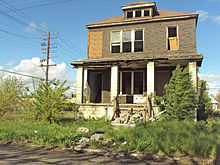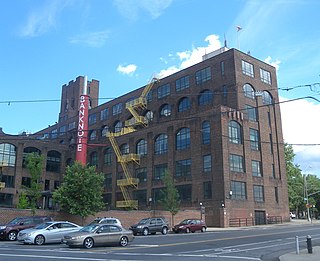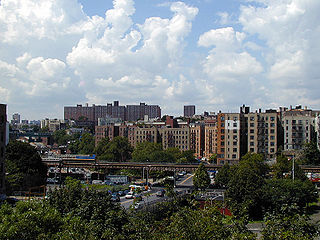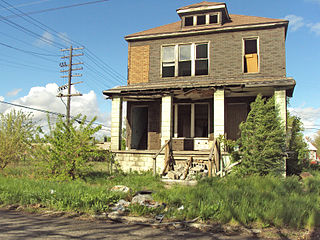Planned shrinkage
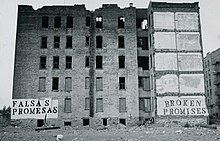
Planned shrinkage is a controversial public policy of the deliberate withdrawal of city services to blighted neighborhoods as a means of coping with dwindling tax revenues. [8] Planned shrinkage involves decreasing city services such as police patrols, garbage removal, street repairs, and fire protection from selected city neighborhoods. It has been advocated as a way to concentrate city services for maximum effectiveness given serious budgetary constraints, but it has been criticized as an attempt to "encourage the exodus of undesirable populations" [8] and to open up blighted neighborhoods for development by private interests.
Planned shrinkage occurred in the South Bronx of New York City and in the city of New Orleans. [9] [10] The term was first used in New York City in 1976 by Housing Commissioner Roger Starr. [11] [12]
For example, in the South Bronx, many firehouses were closed from the 1960s to the 1980s. Although firehouses were shut down all over the city during this period, the average number of people per engine by was over 44,000 in the South Bronx compared to just 17,000 in Staten Island. Firehouses in the Bronx were closed even as the fire alarm rate rose during the 1960s and the 1970s. Many of those planning decisions can be tracked to models created by the Rand corporation. [2] : 7
Background
During the 20th century, a boom in suburban growth caused in part by increased automobile use led to urban decline, particularly in the poorer sections of many large cities in the United States and elsewhere. A dwindling tax base depleted many municipal resources. A common view was that it was part of a "downward spiral" caused first by an absence of jobs, the creation of a permanent underclass, and a declining tax base hurting many city services, including schools. It was that interplay of factors that made change difficult. [13] New York City was described as "so broke" by the 1970s, with neighborhoods that had become "so desperate and depleted" that municipal authorities wondered how to cope. [14] Some authorities felt the process of decline was inevitable and, instead of trying to fight it, searched for alternatives. According to one view, authorities searched for ways to have the greatest population loss in the areas with the poorest non-white populations. [2] [12]
RAND study
In the early 1970s, a RAND study examining the relation between city services and large city populations concluded that when services such as police and fire protection were withdrawn, the numbers of people in the neglected areas would decrease. [2] There had been questions about many fires that had been happening in the South Bronx during the 1970s. One account, including the RAND report, suggested that neighborhood fires were predominantly caused by arson though a contrasting report suggested that arson was not a major cause. [15] If arson was a primary cause, according to the RAND viewpoint, it did not make sense financially for the city to try to invest further funds to improve fire protection The RAND report allegedly influenced then US Senator Daniel Patrick Moynihan, who used the report's findings to make recommendations for urban policy. In Moynihan's view, arson was one of many social pathologies caused by large cities, and he suggested that a policy of "benign neglect" would be appropriate as a response. [2]
Case studies
New York City

Partly in response to the RAND report, and in an effort to address New York's declining population, New York's housing commissioner, Roger Starr, proposed a policy which he termed planned shrinkage to reduce the impoverished population and better preserve the tax base. According to the "politically toxic" proposal, the city would stop investing in troubled neighborhoods and divert funds to communities "that could still be saved." [16] He suggested that the city should "accelerate the drainage" in what he called the worst parts of the South Bronx through a policy of planned shrinkage by closing subway stations, firehouses, and schools. Starr felt that those actions were the best way to save money. [17] Starr's arguments soon became predominant in urban planning thinking nationwide. [12] The people who lived in the communities where his policies were applied protested vigorously; without adequate fire service and police protection, the residents faced waves of crime and fires that left much of the South Bronx and Harlem devastated. [2] A report in 2011 in the New York Times suggested that the planned shrinkage approach was "short-lived." [18]
Under the planned shrinkage program, for example, an abandoned 100-unit development on one piece of land could be cleared by a real estate developer. Such an outcome would be preferable to ten separate neighborhood-based efforts to produce 100 housing units each, according to advocates of planned shrinkage. According to their view, a planned shrinkage approach would encourage so-called "monolithic development," resulting in new urban growth but at much lower population densities than the neighborhoods which had existed previously. [12] The remark by Starr caused a political firestorm, and Mayor Abraham Beame disavowed the idea while City Council members called it "inhuman," "racist," and "genocidal." [11]
According to one report, the high inflation during the 1970s combined with the restrictive rent control policies in the city meant that buildings were worth more dead for the insurance money than alive as sources of rental income. As investments, they had limited ability to provide a solid stream of rental income. Accordingly, there was an economic incentive on the part of building owners, according to this view, to simply let the buildings burn. An alternative view was that the fires were a result of the city's municipal policies. While there are differing views about whether planned shrinkage caused fire outbreaks in the 1970s or was a result of such fires, there is agreement that the fires in the South Bronx during those years were extensive. [2]
In the South Bronx, the average number of people per [fire] engine is over 44,000. In Staten Island, it's 17,000. There is no standard for manning areas of multiple dwellings as opposed to one- and two-family residences.
— A New York City battalion chief from the New York City Fire Department interviewed in the BBC-TV special "The Bronx is Burning," in 1976. [2]

By the mid-1970s, the Bronx had 120,000 fires per year, or an average of 30 fires every 2 hours. 40 percent of the housing in the area was destroyed. The response time for fires also increased, as the firefighters did not have the resources to keep responding promptly to numerous service calls. A report in The New York Post suggested that the cause of the fires was not arson but resulted from decisions by bureaucrats to abandon sections of the city. According to one report, of the 289 census tracts within the borough of the Bronx, seven census tracts lost more than 97% of their buildings, with 44 tracts losing more than 50% of their buildings, to fire and abandonment. [15]
There have been claims that planned shrinkage impacted public health negatively. [19] [20] According to one source, public shrinkage programs targeted to undermine populations of African-Americans and Hispanic-Americans in the South Bronx and Harlem had an effect on the geographic pattern of the AIDS outbreak. According to this view, municipal abandonment was interrelated with health issues and helped to cause a phenomenon termed "urban desertification". [21]
The populations in the South Bronx, Lower East Side, and Harlem plummeted during the two decades after 1970. Only then would the city again begin to invest in these areas.[ citation needed ]
New Orleans
New Orleans differed from other cities in that the cause of decline was based not on economic or political shifts but by rather a destructive flood caused by a hurricane. In the aftermath of Hurricane Katrina, planned shrinkage was proposed as a means to create a "more compact, more efficient and less flood-prone city". [10] Areas of the city that were most damaged by the flooding and thus were the most likely to be flooded again would not be rebuilt but become green space. [10] Those areas were frequently less desirable, lower-income areas which had lower property values precisely because of the risk of flooding. [10] Some residents rejected a "top-down" approach of planned shrinkage of municipal planners and attempted to rebuild in flood-prone areas. [9]
Detroit
The city of Detroit has gone through a major economic and demographic decline in recent decades. The population of the city has fallen from a high of 1,850,000 in 1950 to 677,116 in 2015, kicking it off the top 20 of US cities by population for the first time since 1850. [22] However, the city has a combined statistical area of 5,318,744 people, which currently ranks 12th in the United States. Local crime rates are among the highest in the United States (however, the overall crime rate in the city has seen a decline during the 21st century [23] ), and vast areas of the city are in a state of severe urban decay. In 2013, Detroit filed the largest municipal bankruptcy case in US history, which it successfully exited on December 10, 2014. Poverty, crime, shootings, drugs and urban blight in Detroit continue to be ongoing problems.
As of 2017 [update] median household income is rising, [24] criminal activity is decreasing by 5% annually as of 2017, [25] and the city's blight removal project is making progress in ridding the city of all abandoned homes that cannot be rehabilitated.
Roxbury, Boston
Planned shrinkage in Roxbury, Boston is not unique to the RAND policies enacted in the 1970s and 1980s. The neighborhood succumbed to numerous fires by out-of-town landlords seeking out the only way to earn back some profit on homes that no longer sold. However, the neighborhood's response to planned shrinkage through community action has made it an example to other neighborhoods of the success of people-first organizing. The neighborhood had worked with the Boston's administration but refused to give in to bureaucratic control by the city and protested whenever the city neglected its redevelopment. [26]
